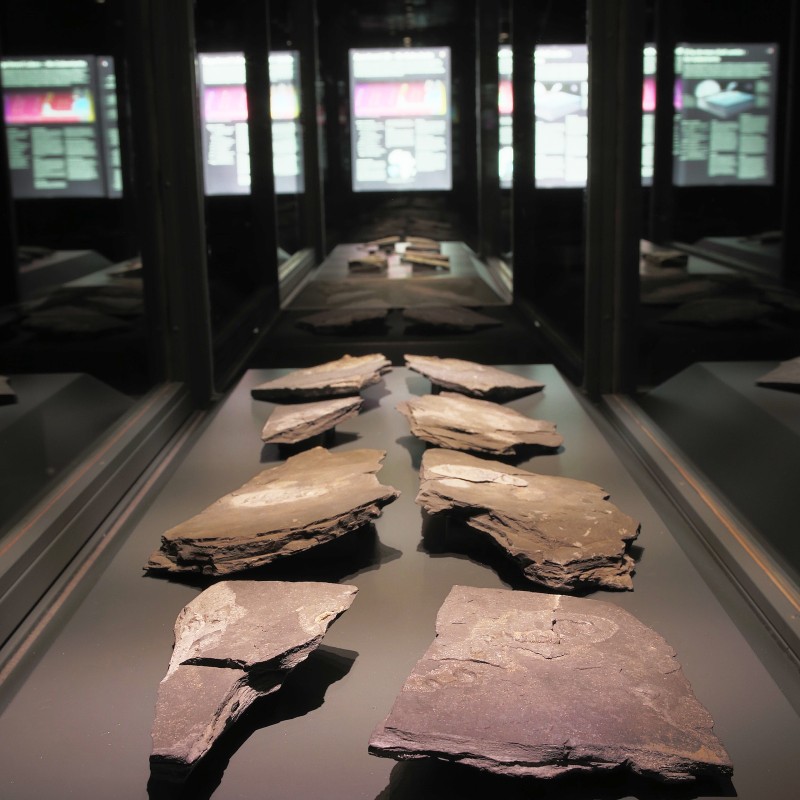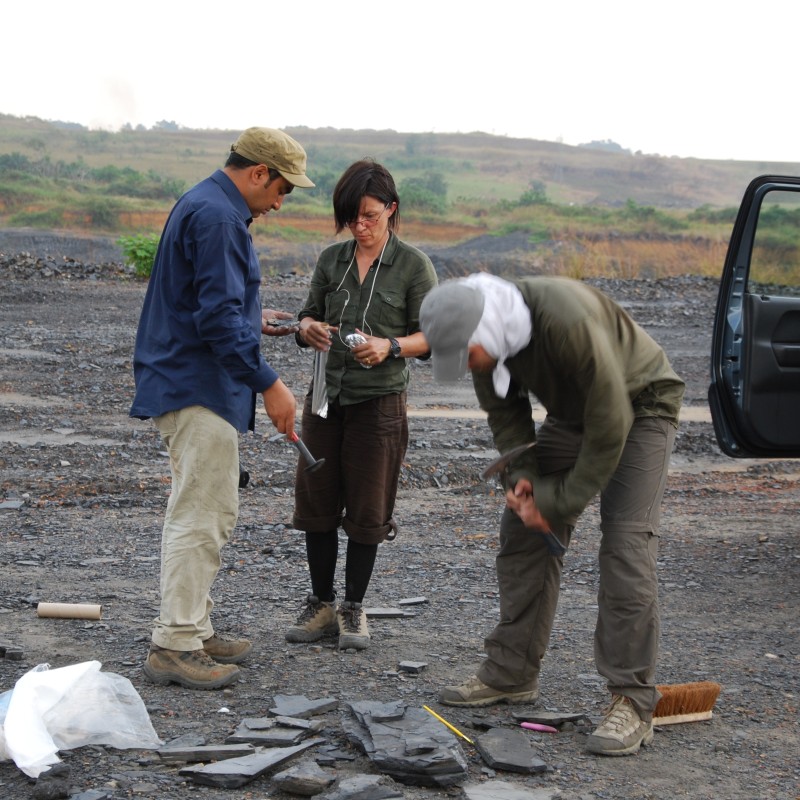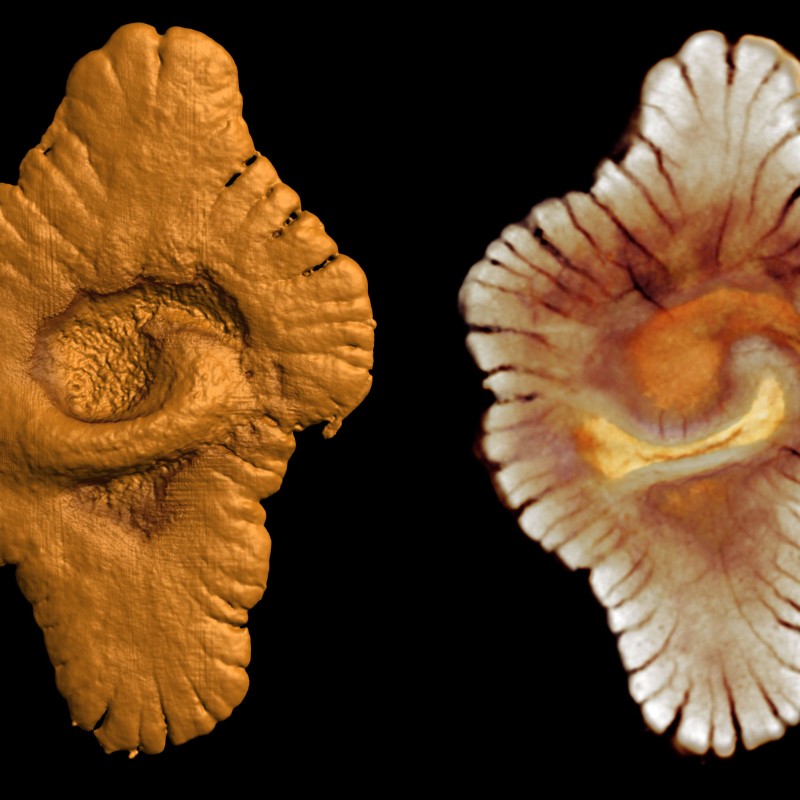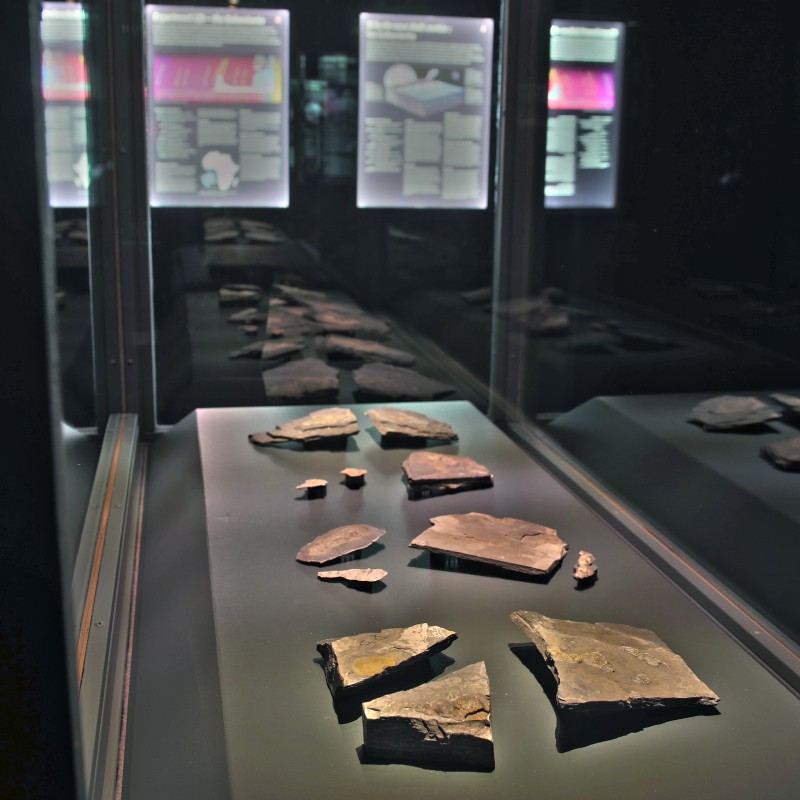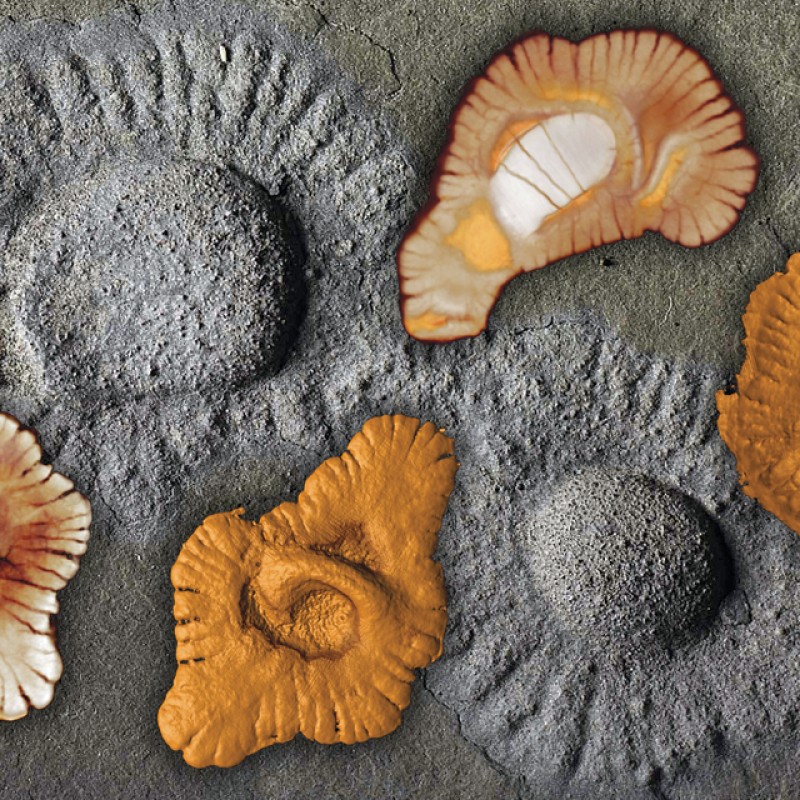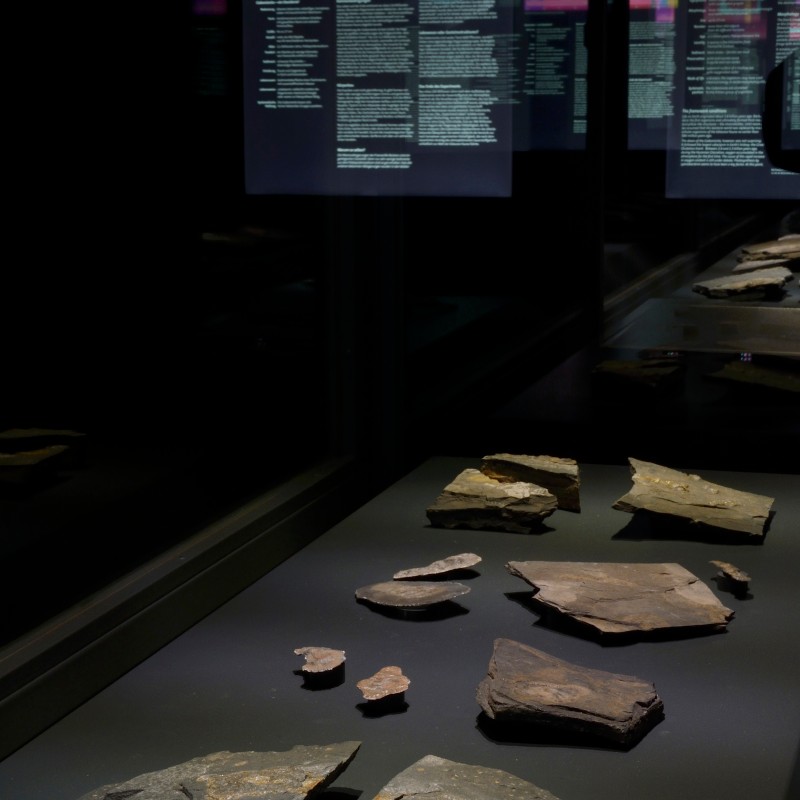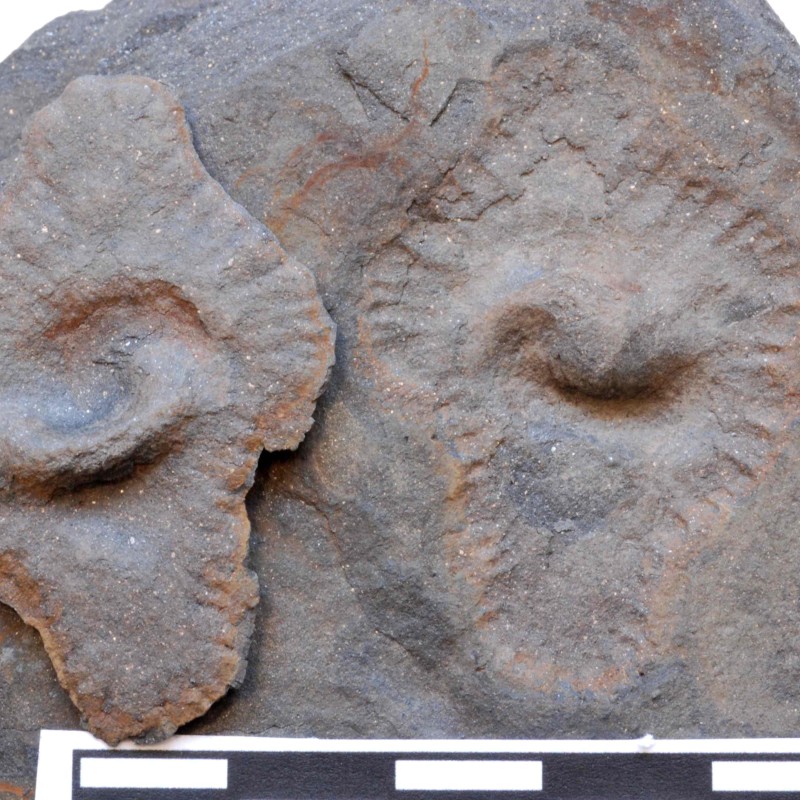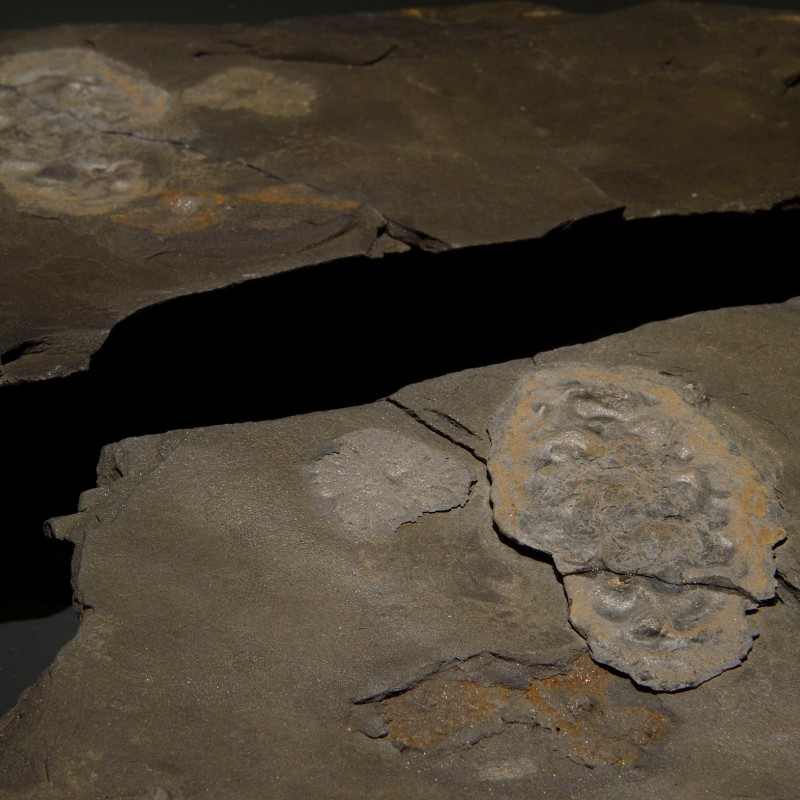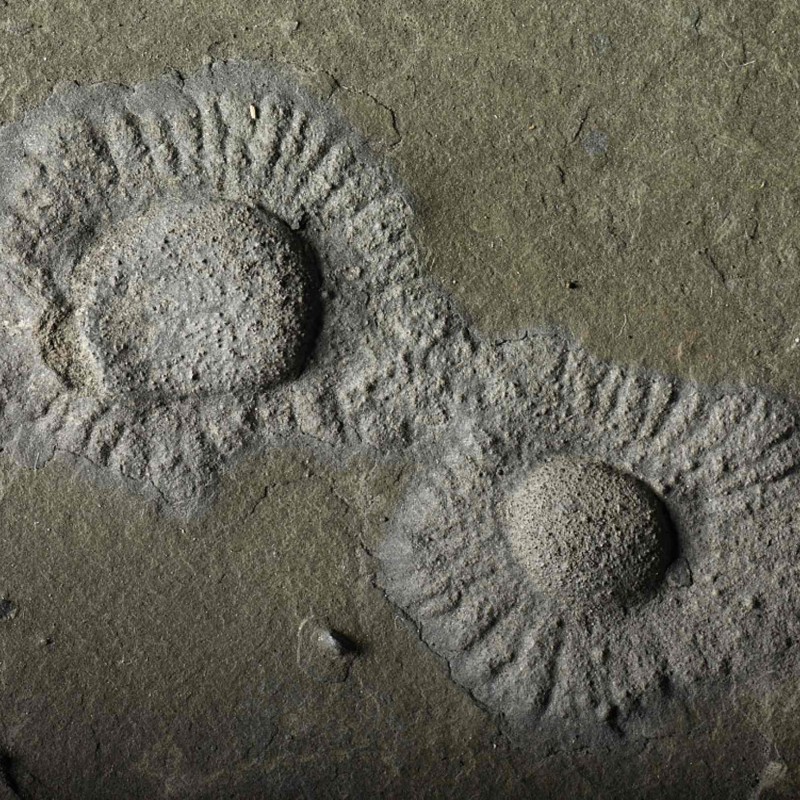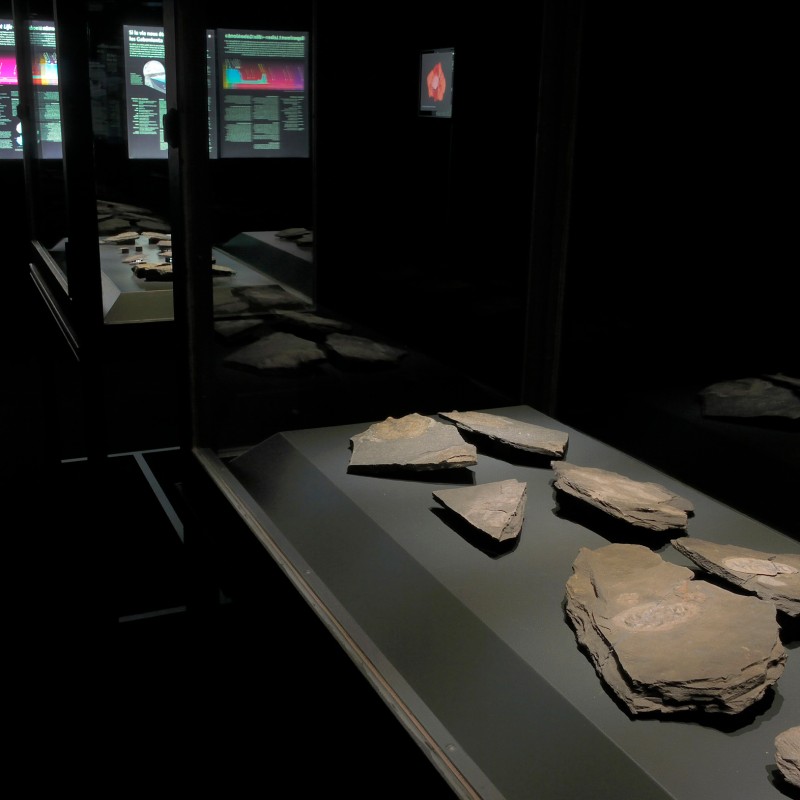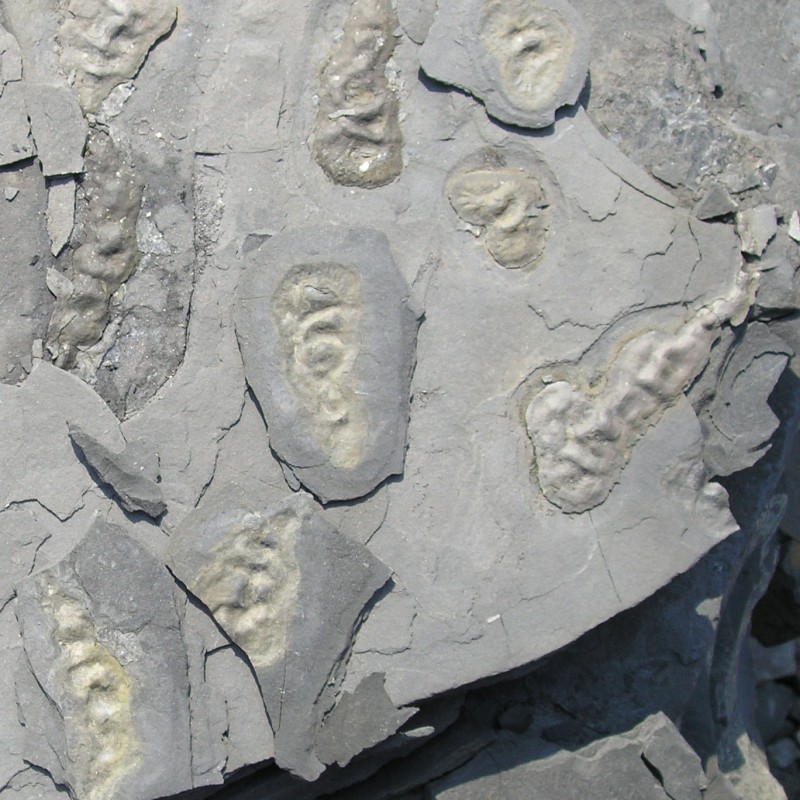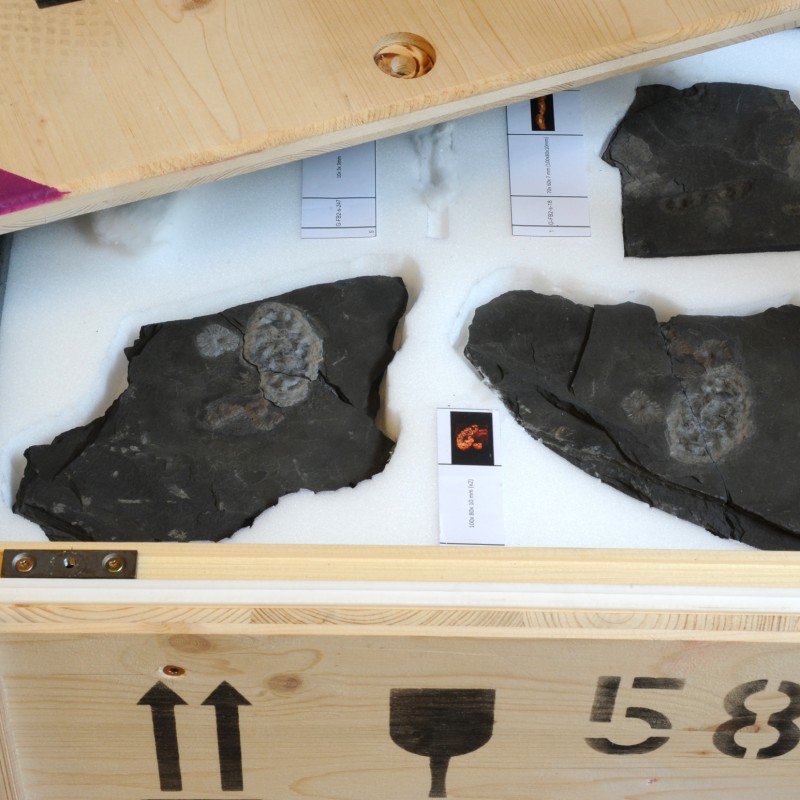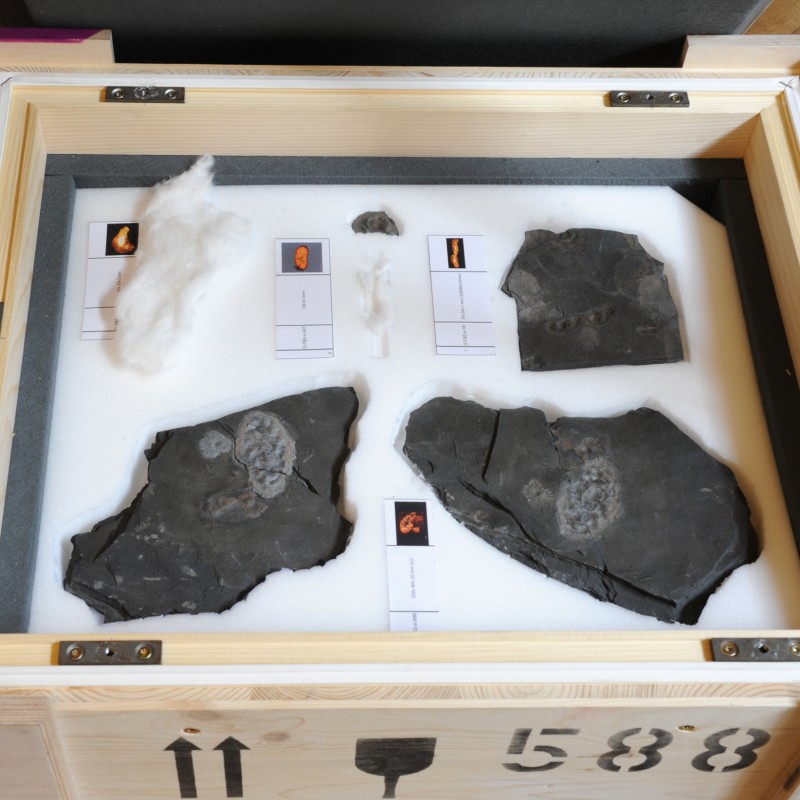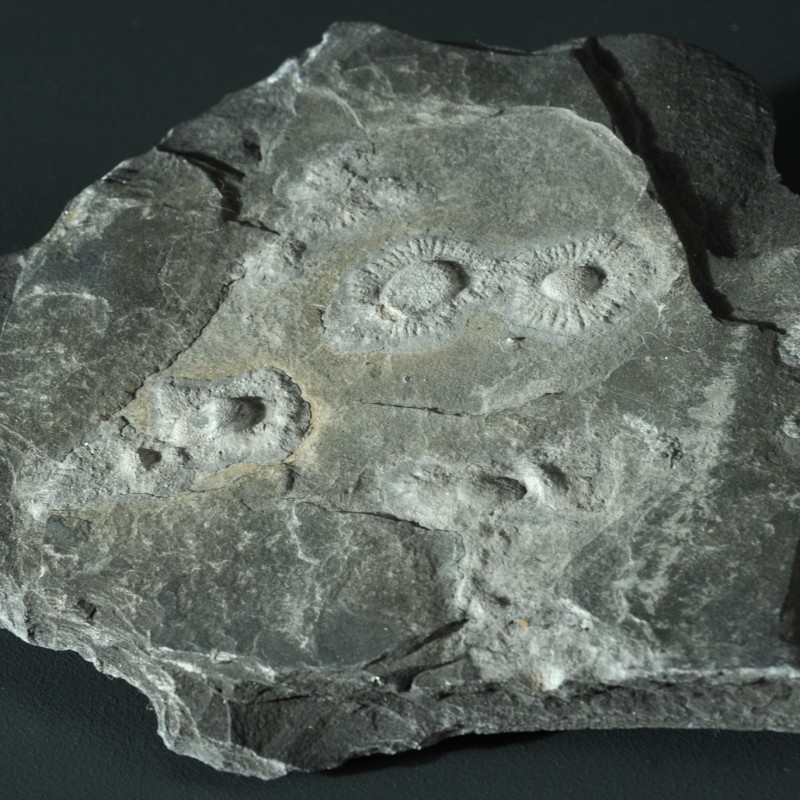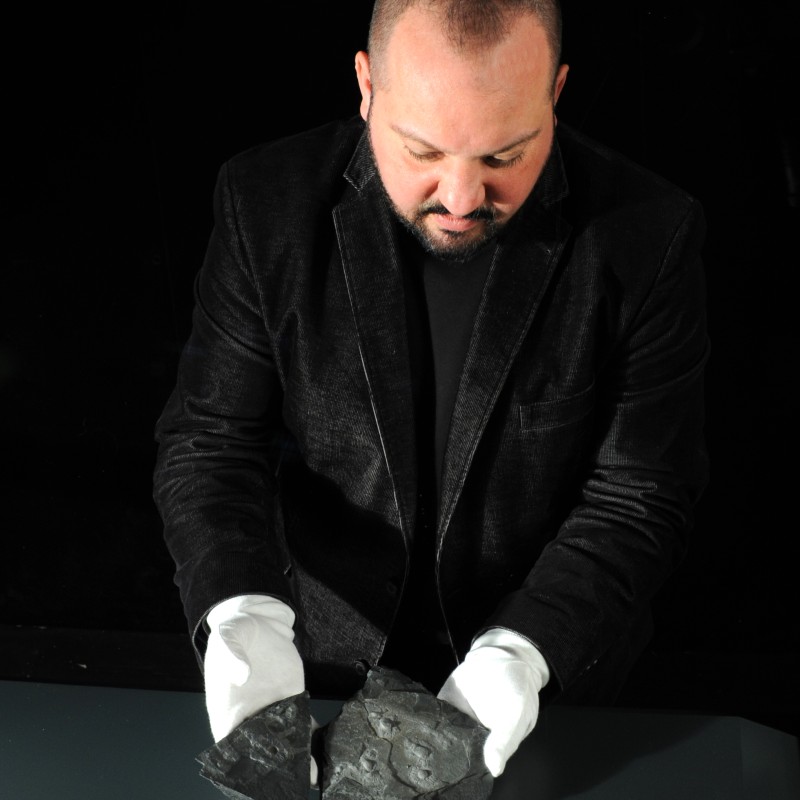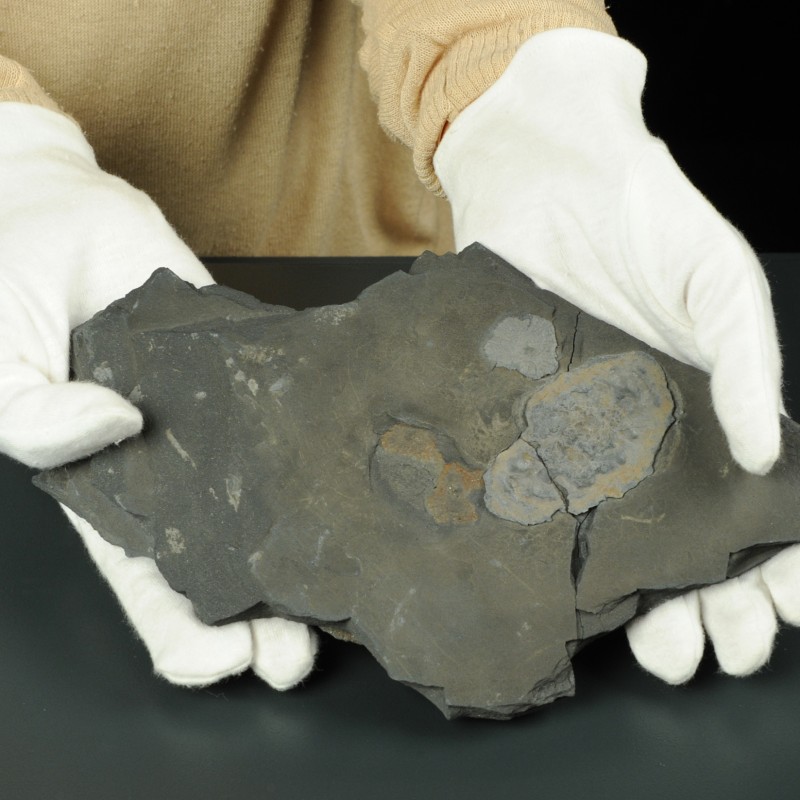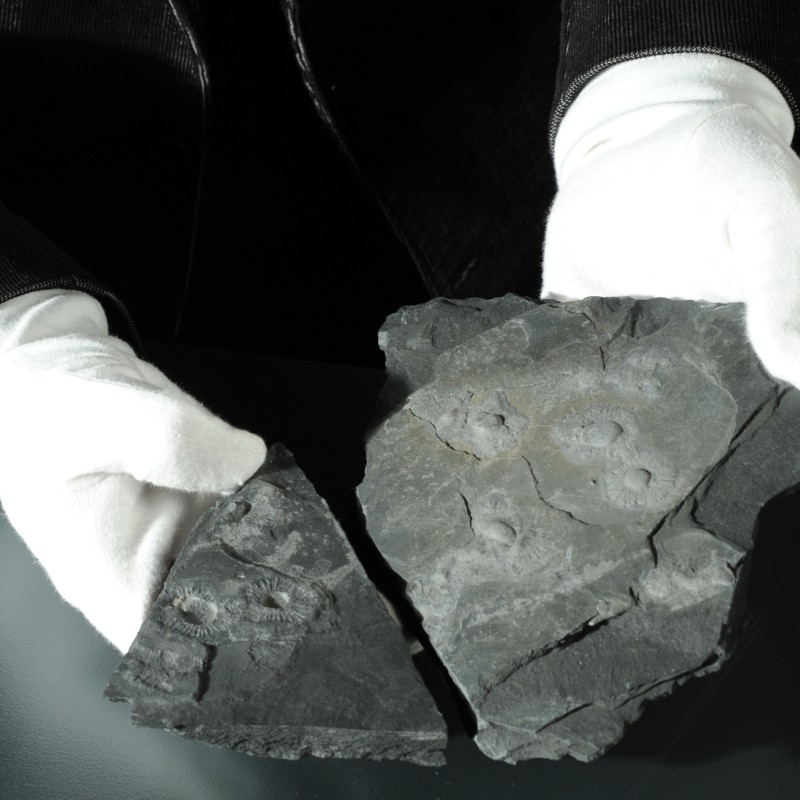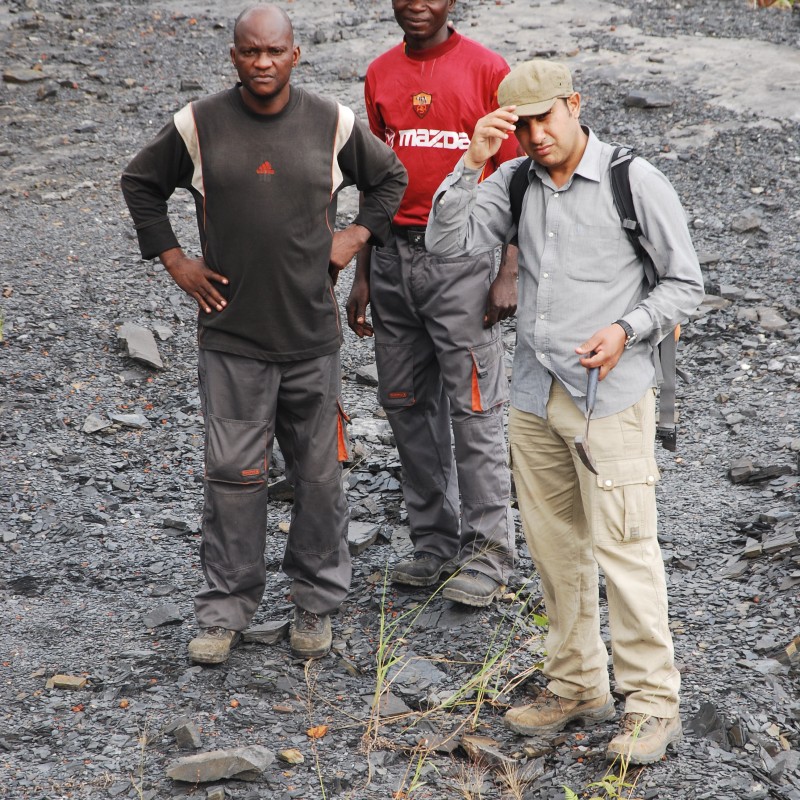Experiment Life – the Gabonionta
07. March 2014
A world premiere – the Natural
History Museum in Vienna is the first to show the oldest fossils of macroscopic multicellular life - 12th of March until 30th
of June 2014
In 2010, an article in the journal Nature hit like
a bombshell. The French-Moroccan geologist Abderrazak El Albani from the University of Poitiers and French National Center
for Scientific Research (CNRS) described the oldest macrofossils of complex, colonial organisms from 2.1-billion-year-old
shales from Gabon. These outstanding fossils were investigated by an international team of scientists led by Professor El
Albani. This sensational discovery fundamentally changed our understanding of evolution and pushed back the known origin of
multicellularity about 1.5 billion years.
The Gabonionta and the origin of life
Earliest geochemical traces of life are known from metamorphic rocks in West Greenland. Carbon signatures in graphite with low levels of the stable isotope C13 indicate that organisms preferentially incorporated the light carbon isotope C12 during metabolism.[1] The oldest body fossils are much younger and became preserved as microbial mats in 3.48-billion-year-old rocks in Australia.[2] Bacteria and Archaea communities, some forming stromatolites of thick mats and pillow-like structures, were the dominant expression of life during the Archean Eon. Fossil eukaryotes, distinguished from the prokaryotes by their nucleus and organelles, are at least 1.8 billion years old.[3] This Proterozoic origin is supported by multigene molecular clock analyses of extant Eukaryota.[4] Nevertheless, eukaryotes may have constituted an important part of the biosphere much earlier, as their characteristic biomarkers appear in 2.7-billion-year-old hydrocarbons of the Pilbara Craton in Australia.[5]
Pinpointing the origin of multicellularity as the next revolution of the biosphere is similarly difficult. It seems to have developed several times independently in various domains of life.[6] Simple types of multicellularity in which single cells communicate with each other are even known from cyanobacteria.[7] Although multicellularity is thus documented since Proterozoic times, the origin of macroscopic multicellularity was traditionally defined much later with the evolution of the Ediacara Fauna 580 million years ago.
Now, Abderrazak El Albani and his team [8] have revolutionized this concept by discovering macroscopic, colonial and multicellular organisms in 2.1-billion-year-old sediments of Gabon – the Gabonionta.
Oxygen as the motor of evolution
From the geochemical point of view, the timing of the origin of the Gabonionta is not pure happenstance.
It followed the biggest revolution in Earth’s history: the “Great Oxidation Event” (GOE). Coinciding with Huronian Glaciation, free oxygen accumulated in the atmosphere for the first time about 2.4-2-3 billion years ago. The cause of this turnover was most probably life itself. Oxygenic photosynthesis by cyanobacteria established itself around 3.1 (or at the latest 2.7) billion years ago as an efficient form of metabolism.[9]
Free oxygen was fixed in the ocean immediately by Fe2+and organic molecules; in the early atmosphere it reacted with the then reducing minerals of the lithosphere. Hence, oxygen first began to accumulate in the atmosphere only after the ocean and lithosphere became oxidized. Nonetheless, the atmosphere was rich in methane. This greenhouse gas was released by bacteria and acted as an additional buffer for molecular oxygen because it quickly oxidizes under UV-light to CO2 and water. When all these oxygen-consuming processes in the hydro-, litho- and atmosphere ceased, the GOE started to change the world.
For some scientists, the abrupt rise of molecular oxygen in the atmosphere at the onset of the GOE raises doubts about this gradualistic model. A key to a better understanding might be ocean chemistry and especially the availability of metal-ions. These are important constituents of enzymes and co-enzymes in many microorganisms, regulating metabolism. Thus, prior to the GOE, methanogenic microorganisms flourished because plenty of nickel as an essential co-enzyme component was available.[10] The cooling lithosphere meant less input of nickel into the biosphere via volcanos. Biological methanogenesis was suppressed – more free oxygen could accumulate. Molybdenum was another limiting factor. It is crucial for nitrogen-fixation in cyanobacteria and thus regulates an ecosystem’s photosynthesis performance.[11] In the oxygen-depleted but sulfide-rich ocean before the GOE, this element was mainly bound as molybdenum disulfide and unavailable to life. With increasing amounts of oxygen in the water, molybdenum became available as oxidized, soluble molybdate – a positive, oxygen-producing feedback mechanism set in.[12] In addition, the formation of hundreds of new minerals in an oxygenated atmosphere resulted in a new weathering-chemistry mobilizing new nutrients. This stimulated oceanic primary productivity and oxygen output.[13] The resulting oxygen-high was most probably the prerequisite for evolution and success of the Gabonionta.
Complexity and coordinated growth
Up to the discovery of the Gabonionta, only two candidates for macroscopic multicellularity were known: Grypania spiralis, a tube-shaped, coiled, several-cm-long structure, which appeared 2.1 billion years ago in India, China and North America [3, 14], and the string-of-beads-like Horodyskia from 1.5-billion-year-old rocks of Montana and Australia.[15] Grypania is mainly interpreted as eukaryote algae [14], and Horodyskia might represent an early fungus.[15] Both organisms are morphologically not very complex and are also reminiscent of macroscopic Archaea-Bacteria communities. [3] This interpretation can be excluded for the Gabonionta based on their complex morphology. More than 450 specimens from 45 different horizons have been found so far. The up to 17-cm-sized fossils represent several distinct morphotypes. Some specimens are more or less circular in outline, others are elongate and resemble flatworms. It remains unclear if the various shapes represent distinct species or if all the fossils derive from a single variable species. Nevertheless, the morphological groups can be categorized in distinct morphotypes, pointing to the presence of numerous species. El Albani and his team analyzed the fossils in a Micro-CT to document their internal structure. These data enable a virtual 3D-reconstruction and revealed a common organization of the Gabonionta. An ellipsoid or spherical central element is typical. It was flexible and often exhibits several folds. The folding might have been caused by postmortem deformation of the gelatinous central element. This central body is surrounded by a fringe with distinct radial structure and scalloped margin. El Albani interpreted this complex organization as the geologically oldest evidence for coordinated growth and intercellular communication.
The quarry is located a few kilometers NW from Franceville in the basin of the same name, in which Paleoproterozoic sand- and silt/mudstones of the Franceville Group are exposed over an area of 35,000 km2.
The fossils were collected from black shales that were once deposited in coastal environments of a shallow sea. Many slabs yield numerous fossils in-situ with densities of up to 40 specimens per m2.[8] Apparently, the Gabonionta lived in dense colonies on the sediment-surface of a shallow sea with oxygenated water. Now, the organisms are preserved as print and counter-print in pyrite and iron oxides. This preservation allowed El Albani’s team to exclude that the fossils are abiogenic structures. Mass-spectrometry analyses of the sulfur isotopes revealed depleted δ34S values in pyrite crystals within the fossils. This signature points to early pyritization of the organic remnants by sulphate-reducing bacteria. A further proof is the isotopic composition of the organic carbon within the fossils, which differs from that of the host rock.[8]
The end of the experiment
The time slot for the evolution of the Gabonionta was tightly bound to the Great Oxidation Event.[8] Similarly, their disappearance might have been coupled with the development of the atmosphere. A mere 100 million years after the bloom of the Gabonionta, the oxygen level in the atmosphere fell drastically.[16] Again, Proterozoic marine deposits of the Franceville Basin in Gabon contain the key. In sedimentary successions younger than those containing the Gabonionta, the team of Donald E. Canfield and Abderrazak El Albani detected, in 2013, a rapid switch from oxygenated deep water towards oxygen-poor conditions from 2.15 to 2.08 billion years.[16] This oxygen-crisis followed a global phase in which huge amounts of organic carbon became stored in sediments – the Lomagundi Event. The strongest positive deviation of 13C in Earth’s history is the geochemical expression of this event.[17] The marked increase in primary productivity during the GOE was caused by oxidative weathering of the lithosphere and the mobilization of nutrients such as phosphorous.[18] Consequently, the first marine sulfate and phosphate deposits formed during the Lomagundi Event. Later, the sediments that had accumulated during the about 100-million-year-long Lomagundi-Event became exposed again to weathering by tectonics. Now, the stored organic carbon acted as an enormous sink for atmospheric oxygen. [16] At that point, the system Earth switched into a stable phase, often referred to as “Boring Billion“, which came to an end with the extreme climate changes during the "Snowball-Earth” phase.
The exhibition
Despite their evidence for the evolution of life, the Gabon fossils have never before been open to the public. The Natural History Museum Vienna for the first time provides insight into the world of the Gabonionta. The exhibition has been enabled by the cooperativeness of Prof. Dr. Abderrazak El Albani from the University of Poitiers-CNRS and by the initiative of Dr. Jean-Luc Steffan, Attaché for science and university cooperation at the French embassy in Vienna.
The best-preserved specimens will be presented in two display cabinets in hall 6 to document the variety of this oldest known complex ecosystem. Video clips feature virtual 3D reconstructions of several individuals. These animations are based on Micro-CT data and provide a spectacular insight into the internal organization of the organisms. Further information is provided in a 40-minute film by the University of Poitiers, featuring expert interviews and views of the fossil-locality. For the exhibition the film was translated from French into German by the Institute of Translation Science of the University of Innsbruck, under the guidance of Mag. Martina Mayer, in cooperation with the French Embassy in Vienna.
The exhibition is being curated by staff members of the Geological-Paleontological Department of the NHM together with Prof. Dr. Abderrazak El Albani.
The Gabonionta and the origin of life
Earliest geochemical traces of life are known from metamorphic rocks in West Greenland. Carbon signatures in graphite with low levels of the stable isotope C13 indicate that organisms preferentially incorporated the light carbon isotope C12 during metabolism.[1] The oldest body fossils are much younger and became preserved as microbial mats in 3.48-billion-year-old rocks in Australia.[2] Bacteria and Archaea communities, some forming stromatolites of thick mats and pillow-like structures, were the dominant expression of life during the Archean Eon. Fossil eukaryotes, distinguished from the prokaryotes by their nucleus and organelles, are at least 1.8 billion years old.[3] This Proterozoic origin is supported by multigene molecular clock analyses of extant Eukaryota.[4] Nevertheless, eukaryotes may have constituted an important part of the biosphere much earlier, as their characteristic biomarkers appear in 2.7-billion-year-old hydrocarbons of the Pilbara Craton in Australia.[5]
Pinpointing the origin of multicellularity as the next revolution of the biosphere is similarly difficult. It seems to have developed several times independently in various domains of life.[6] Simple types of multicellularity in which single cells communicate with each other are even known from cyanobacteria.[7] Although multicellularity is thus documented since Proterozoic times, the origin of macroscopic multicellularity was traditionally defined much later with the evolution of the Ediacara Fauna 580 million years ago.
Now, Abderrazak El Albani and his team [8] have revolutionized this concept by discovering macroscopic, colonial and multicellular organisms in 2.1-billion-year-old sediments of Gabon – the Gabonionta.
Oxygen as the motor of evolution
From the geochemical point of view, the timing of the origin of the Gabonionta is not pure happenstance.
It followed the biggest revolution in Earth’s history: the “Great Oxidation Event” (GOE). Coinciding with Huronian Glaciation, free oxygen accumulated in the atmosphere for the first time about 2.4-2-3 billion years ago. The cause of this turnover was most probably life itself. Oxygenic photosynthesis by cyanobacteria established itself around 3.1 (or at the latest 2.7) billion years ago as an efficient form of metabolism.[9]
Free oxygen was fixed in the ocean immediately by Fe2+and organic molecules; in the early atmosphere it reacted with the then reducing minerals of the lithosphere. Hence, oxygen first began to accumulate in the atmosphere only after the ocean and lithosphere became oxidized. Nonetheless, the atmosphere was rich in methane. This greenhouse gas was released by bacteria and acted as an additional buffer for molecular oxygen because it quickly oxidizes under UV-light to CO2 and water. When all these oxygen-consuming processes in the hydro-, litho- and atmosphere ceased, the GOE started to change the world.
For some scientists, the abrupt rise of molecular oxygen in the atmosphere at the onset of the GOE raises doubts about this gradualistic model. A key to a better understanding might be ocean chemistry and especially the availability of metal-ions. These are important constituents of enzymes and co-enzymes in many microorganisms, regulating metabolism. Thus, prior to the GOE, methanogenic microorganisms flourished because plenty of nickel as an essential co-enzyme component was available.[10] The cooling lithosphere meant less input of nickel into the biosphere via volcanos. Biological methanogenesis was suppressed – more free oxygen could accumulate. Molybdenum was another limiting factor. It is crucial for nitrogen-fixation in cyanobacteria and thus regulates an ecosystem’s photosynthesis performance.[11] In the oxygen-depleted but sulfide-rich ocean before the GOE, this element was mainly bound as molybdenum disulfide and unavailable to life. With increasing amounts of oxygen in the water, molybdenum became available as oxidized, soluble molybdate – a positive, oxygen-producing feedback mechanism set in.[12] In addition, the formation of hundreds of new minerals in an oxygenated atmosphere resulted in a new weathering-chemistry mobilizing new nutrients. This stimulated oceanic primary productivity and oxygen output.[13] The resulting oxygen-high was most probably the prerequisite for evolution and success of the Gabonionta.
Complexity and coordinated growth
Up to the discovery of the Gabonionta, only two candidates for macroscopic multicellularity were known: Grypania spiralis, a tube-shaped, coiled, several-cm-long structure, which appeared 2.1 billion years ago in India, China and North America [3, 14], and the string-of-beads-like Horodyskia from 1.5-billion-year-old rocks of Montana and Australia.[15] Grypania is mainly interpreted as eukaryote algae [14], and Horodyskia might represent an early fungus.[15] Both organisms are morphologically not very complex and are also reminiscent of macroscopic Archaea-Bacteria communities. [3] This interpretation can be excluded for the Gabonionta based on their complex morphology. More than 450 specimens from 45 different horizons have been found so far. The up to 17-cm-sized fossils represent several distinct morphotypes. Some specimens are more or less circular in outline, others are elongate and resemble flatworms. It remains unclear if the various shapes represent distinct species or if all the fossils derive from a single variable species. Nevertheless, the morphological groups can be categorized in distinct morphotypes, pointing to the presence of numerous species. El Albani and his team analyzed the fossils in a Micro-CT to document their internal structure. These data enable a virtual 3D-reconstruction and revealed a common organization of the Gabonionta. An ellipsoid or spherical central element is typical. It was flexible and often exhibits several folds. The folding might have been caused by postmortem deformation of the gelatinous central element. This central body is surrounded by a fringe with distinct radial structure and scalloped margin. El Albani interpreted this complex organization as the geologically oldest evidence for coordinated growth and intercellular communication.
The quarry is located a few kilometers NW from Franceville in the basin of the same name, in which Paleoproterozoic sand- and silt/mudstones of the Franceville Group are exposed over an area of 35,000 km2.
The fossils were collected from black shales that were once deposited in coastal environments of a shallow sea. Many slabs yield numerous fossils in-situ with densities of up to 40 specimens per m2.[8] Apparently, the Gabonionta lived in dense colonies on the sediment-surface of a shallow sea with oxygenated water. Now, the organisms are preserved as print and counter-print in pyrite and iron oxides. This preservation allowed El Albani’s team to exclude that the fossils are abiogenic structures. Mass-spectrometry analyses of the sulfur isotopes revealed depleted δ34S values in pyrite crystals within the fossils. This signature points to early pyritization of the organic remnants by sulphate-reducing bacteria. A further proof is the isotopic composition of the organic carbon within the fossils, which differs from that of the host rock.[8]
The end of the experiment
The time slot for the evolution of the Gabonionta was tightly bound to the Great Oxidation Event.[8] Similarly, their disappearance might have been coupled with the development of the atmosphere. A mere 100 million years after the bloom of the Gabonionta, the oxygen level in the atmosphere fell drastically.[16] Again, Proterozoic marine deposits of the Franceville Basin in Gabon contain the key. In sedimentary successions younger than those containing the Gabonionta, the team of Donald E. Canfield and Abderrazak El Albani detected, in 2013, a rapid switch from oxygenated deep water towards oxygen-poor conditions from 2.15 to 2.08 billion years.[16] This oxygen-crisis followed a global phase in which huge amounts of organic carbon became stored in sediments – the Lomagundi Event. The strongest positive deviation of 13C in Earth’s history is the geochemical expression of this event.[17] The marked increase in primary productivity during the GOE was caused by oxidative weathering of the lithosphere and the mobilization of nutrients such as phosphorous.[18] Consequently, the first marine sulfate and phosphate deposits formed during the Lomagundi Event. Later, the sediments that had accumulated during the about 100-million-year-long Lomagundi-Event became exposed again to weathering by tectonics. Now, the stored organic carbon acted as an enormous sink for atmospheric oxygen. [16] At that point, the system Earth switched into a stable phase, often referred to as “Boring Billion“, which came to an end with the extreme climate changes during the "Snowball-Earth” phase.
The exhibition
Despite their evidence for the evolution of life, the Gabon fossils have never before been open to the public. The Natural History Museum Vienna for the first time provides insight into the world of the Gabonionta. The exhibition has been enabled by the cooperativeness of Prof. Dr. Abderrazak El Albani from the University of Poitiers-CNRS and by the initiative of Dr. Jean-Luc Steffan, Attaché for science and university cooperation at the French embassy in Vienna.
The best-preserved specimens will be presented in two display cabinets in hall 6 to document the variety of this oldest known complex ecosystem. Video clips feature virtual 3D reconstructions of several individuals. These animations are based on Micro-CT data and provide a spectacular insight into the internal organization of the organisms. Further information is provided in a 40-minute film by the University of Poitiers, featuring expert interviews and views of the fossil-locality. For the exhibition the film was translated from French into German by the Institute of Translation Science of the University of Innsbruck, under the guidance of Mag. Martina Mayer, in cooperation with the French Embassy in Vienna.
The exhibition is being curated by staff members of the Geological-Paleontological Department of the NHM together with Prof. Dr. Abderrazak El Albani.
Computer-tomography and reconstruction of a 35-mm-long specimen [5]
© Abderrazak El Albani, University of Poitiers
Two fossils on a slab showing the typical central body and fringe; width
c. 5 cm [6]
© Abderrazak El Albani,
University of Poitiers

